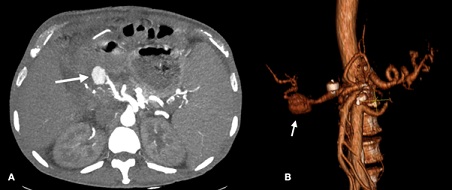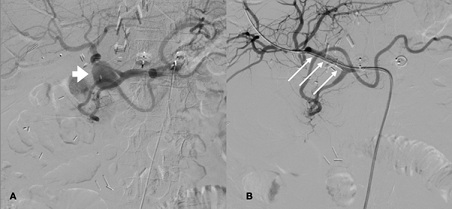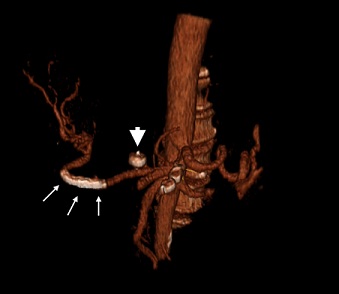
Hepatic Artery Pseudoaneurysm after Hepatic Transplant - Endovascular Treatment with Graft Stenting
*Corresponding Author(s):
Nuno Miguel Ferreira CamposDepartment Of Medical Imaging - Coimbra Hospital And University Centre (CHUC), Coimbra, Portugal
Tel:+351 239400431,
Email:nunocampos.bf@gmail.com
Abstract
Hepatic Artery Pseudoaneurysms (HAP) after liver transplantation are rare and associated with high mortality. Different treatment options exist for HAP, which include surgical intervention, radiological coil embolization or stenting and retransplantation.
We describe a case of a patient presenting with HAP after a liver transplantion, that was successfully treated with stent grafting, allowing preservation of the arterial flow and minimal risk of organ failure.
Endovascular intervention of HAP should be regarded as the treatment of choice, either in symptomatic or in asymptomatic patients.
Keywords
Hepatic artery pseudoaneurysm; Liver transplantation; Stent-grafting
Introduction
Hepatic artery Pseudoaneurysms (HAP) after liver transplantation are rare, with reported incidence between 1 and 2% [1]. They usually occur within the first month after transplantation and are commonly associated with localized infection [2]. The mortality associated with HAP formation after is high (69%), particularly if surgical intervention is performed as an emergency following acute hemorrhage [2].
HAP can be classified as intrahepatic or extrahepatic according to its location. Intrahepatic pseudoaneurysms may result from previous procedures, such as liver biopsy and percutaneous transhepatic biliary drainage, whereas extrahepatic pseudoaneurysms are commonly associated with localized infection or anastomotic complications [2].
Different treatment options exist for HAP, which include surgical resection and revascularization, radiological coil embolization or stenting and retransplantation [1].
Case Report
A 56-year-old male patient presented to routine follow-up consultation 40 days after orthotopic liver transplantation from deceased donor. It was his second graft, due to failure related to ischemic cholangiopathy of the first one, implanted 9 months earlier. In the previous transplantation he developed splenic artery steal syndrome, treated successfully with splenic artery coiling.
In the second transplant, hepatic arteries and portal veins of the donor and recipient were anastomosed end-to-end and bile duct reconstruction was performed with a duct-to-duct anastomosis. Intraoperative findings showed no abnormalities in the hepatic artery, portal vein, hepatic vein or bile duct.
In the hepatic Doppler ultrasound, performed at the 40th day consultation, it was noted a fluid collection in the hepatic hilum, apparently of vascular origin, and an urgent abdominal CT was performed. The CT showed a large HAP, measuring 3 cm of diameter, near the hepatic artery anastomosis (Figure 1).
 Figure 1: HAP. Abdominal angio-CT, with MIP and VR reformatting, showing a large contrast enhancing pseudoaneurysm near the hepatic artery anastomosis (arrows in A and B). MIP - Maximum Intensity Projection; VR - Volume Rendering.
Figure 1: HAP. Abdominal angio-CT, with MIP and VR reformatting, showing a large contrast enhancing pseudoaneurysm near the hepatic artery anastomosis (arrows in A and B). MIP - Maximum Intensity Projection; VR - Volume Rendering.
The hepatic transplantation and interventional radiology teams reviewed the case and discussed with the patient the options, recommending an endovascular approach.
The patient was taken to the angiography lab and Digital Subtraction Angiography (DSA) confirmed the HAP (Figure 2A). Due to the site of the HAP, and suitable anatomy (no kinking or bifurcations), a stent-grafting with 2 covered stents ( Advanta V12 ™ Balloon Expandable Covered Stent 5 x 22 mm, Getinge®, Gotemburg, Sweden) was performed (Figure 2B). First the right hepatic artery was reached with a hydrophilic guide wire (Terumo® 0,035’’ x 180 cm, Tokyo, Japan), allowing the catheterization with a 4F multipurpose catheter and the guide was replaced by a more rigid one (Starter ™ 0,035’’ x 260 cm, J tip, Boston Scientific ®, Massachusetts, USA). An introducer sheath (Destination ™ 7F, 45 cm, Terumo®, Tokyo, Japan) was then positioned at the site of the anastomosis allowing the subsequent release of the first stent graft that did not completely exclude the pseudoaneurysm. Thus, the proximal portion of the stent graft was prolonged with a second partially overlapping stent, leading to the complete exclusion of the pseudoaneurysm.
 Figure 2: DSA confirming the presence of a HAP (thick arrow in A). Stent grafting with 2 Advanta V12 Balloon Expandable Covered Stents 5 x 22 mm, showing good end result, with HAP totally excluded (B). DSA - digital subtraction angiography; HAP - hepatic artery pseudoaneurysm.
Figure 2: DSA confirming the presence of a HAP (thick arrow in A). Stent grafting with 2 Advanta V12 Balloon Expandable Covered Stents 5 x 22 mm, showing good end result, with HAP totally excluded (B). DSA - digital subtraction angiography; HAP - hepatic artery pseudoaneurysm.
A follow-up CT performed 5 days after stent placement showed good results, with stents in place and the HAP excluded (Figure 3). Antiplatelet medication with clopidogrel (75 mg) and low-dose acetylsalicylic acid (100 mg), was maintained during the following 6 months. Presently, with a 10 month follow-up the patient did not present infection or hemorrhagic complications and the stent-graft is patent.
 Figure 3: Abdominal angio-CT, with VR reformatting, performed 5 days after the intervention, showing the stents in place (small arrows), with no thrombosis or sign of the HAP. There are also signs of previous venous embolization of a large left gastric vein with an amplatzer plug device (large arrow).
Figure 3: Abdominal angio-CT, with VR reformatting, performed 5 days after the intervention, showing the stents in place (small arrows), with no thrombosis or sign of the HAP. There are also signs of previous venous embolization of a large left gastric vein with an amplatzer plug device (large arrow).
Discussion
The clinical manifestations of HAP varies from the asymptomatic to abdominal pain with fever, gastrointestinal bleeding (up to 25%) and hemorrhagic shock [1-3].
Post-surgical surveillance ultrasound examination combined with color Doppler, has been shown to improve detection of vascular complications, with DSA still being the gold-standard imaging modality in the evaluation of an aneurysm.
Several factors have been implicated in hepatic artery complications, including: technical imperfections at the anastomosis site and type of reconstruction, intimal dissection, kinking and repeated anastomosis [1].
Treatment options consist of either interventional radiology with insertion of an arterial stent or coiling at the neck of the aneurysm and surgical intervention [1,2,4,5]. Superselective microcoil embolization has been recognized as an effective treatment in patients with extrahepatic pseudoaneurysms of the hepatic arteries [1,2,6]. Embolization is the treatment of choice in biopsy related intrahepatic pseudoaneurysms [1].
The use of covered stents has some technical difficulties, namely in tortuous vessels, such as the hepatic artery due to low flexibility of the endoprosthesis. Not all vessels are adequate for stent placing; however, some strategies can be adopted, such as using a short endoprosthesis, a stiff guidewire and a long introducer sheath.
In the case we presented, the location of the HAP seemed suited for the stents, with no kinking of the vessel. Hepatic artery patency was maintained, preserving arterial blood supply to the liver, which was of particular importance in this patient, who had already been subjected to a second graft placement after ischemic cholangiopathy.
Conclusion
Endovascular intervention of HAP should be regarded as the treatment of choice, either in order to stabilize an active bleed or to prevent it, with advantage of flow preserving techniques such as the use of stent grafts.
Conflicts of Interest Statement
The authors certify that they have NO affiliations with or involvement in any organization or entity with any financial interest (such as honoraria; educational grants; participation in speakers’ bureaus; membership, employment, consultancies, stock ownership, or other equity interest; and expert testimony or patent-licensing arrangements), or non-financial interest (such as personal or professional relationships, affiliations, knowledge or beliefs) in the subject matter or materials discussed in this manuscript.
References
- Karatzas T, Lykaki-Karatzas E, Webb M, Nery J, Tsaroucha A, et al. (1997) Vascular complications, treatment, and outcome following orthotopic liver transplantation. Transplant Proc 29: 2853-2855.
- Marshall MM, Muiesan P, Srinivasan P, Kane PA, Rela M, et al. (2001) Hepatic artery pseudoaneurysms following liver transplantation: incidence, presenting features and management. Clin Radiol 56: 579-587.
- Piardi T, Lhuaire M, Bruno O, Memeo R, Pessaux P, et al. (2015) Vascular complications following liver transplantation: A literature review of advances in 2015. World J Hepatol 8: 36-57.
- Paci E, Antico E, Candelari R, Alborino S, Marmorale C, et al. (2000) Pseudoaneurysm of the common hepatic artery: treatment with a stent-graft. Cardiovasc Intervent Radiol 23: 472-474.
- Patel JV, Weston MJ, Kessel DO, Prasad R, Toogood GJ, et al. (2003) Hepatic artery pseudoaneurysm after liver transplantation: treatment with percutaneous thrombin injection. Transplantation 75: 1755-1757.
- Reber PU, Baer HU, Patel AG, Wildi S, Triller J, et al. (1998) Superselective microcoil embolization: treatment of choice in high-risk patients with extrahepatic pseudoaneurysms of the hepatic arteries. J Am Coll Surg 186: 325-330.
Citation: Campos NMF, Donato P (2022) Hepatic Artery Pseudoaneurysm after Hepatic Transplant - Endovascular Treatment with Graft Stenting. J Angiol Vasc Surg 7: 089.
Copyright: © 2022 Nuno Miguel Ferreira Campos, et al. This is an open-access article distributed under the terms of the Creative Commons Attribution License, which permits unrestricted use, distribution, and reproduction in any medium, provided the original author and source are credited.

